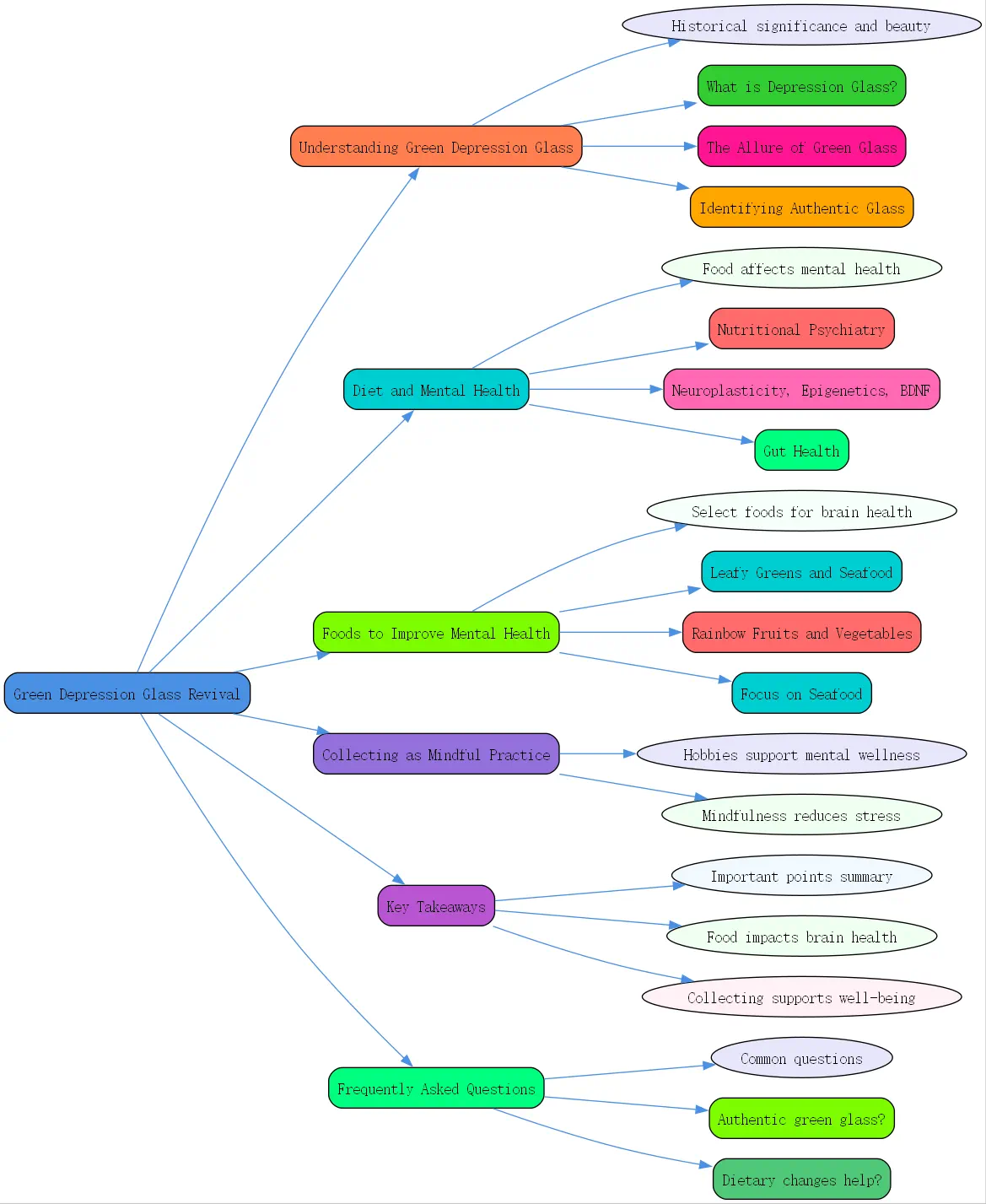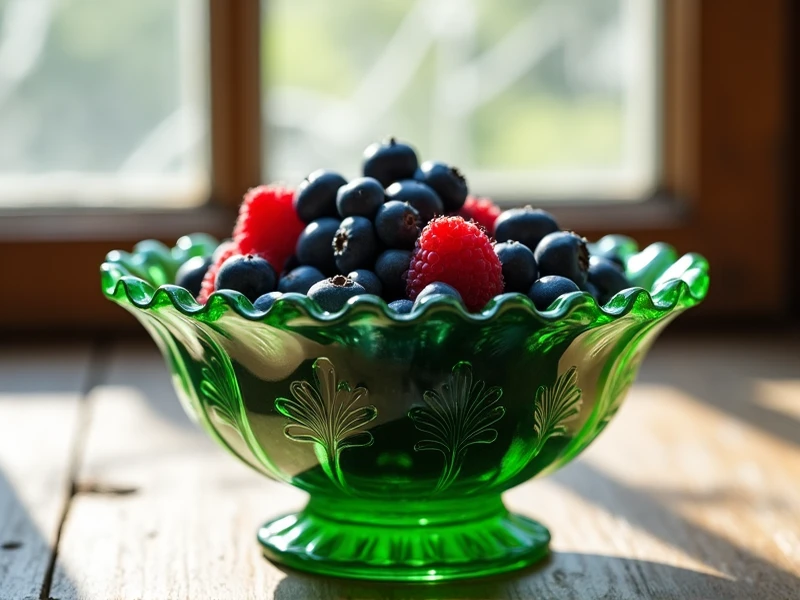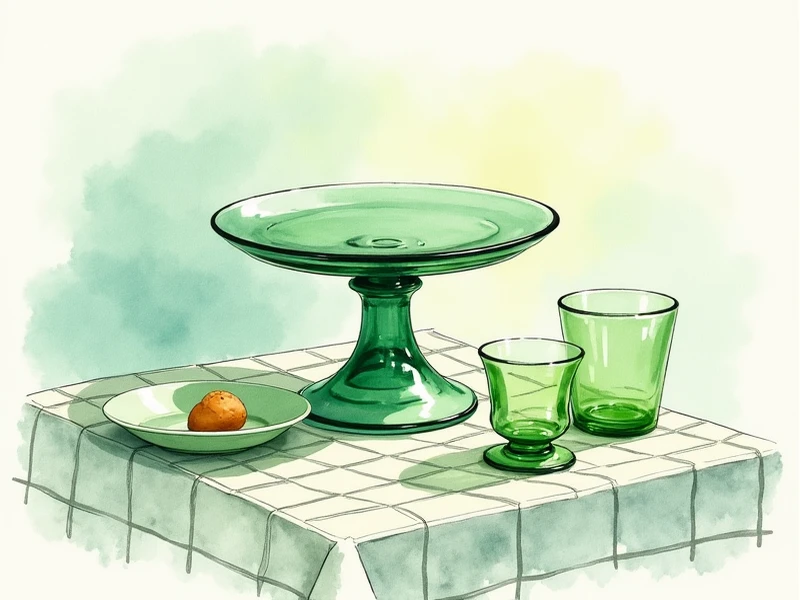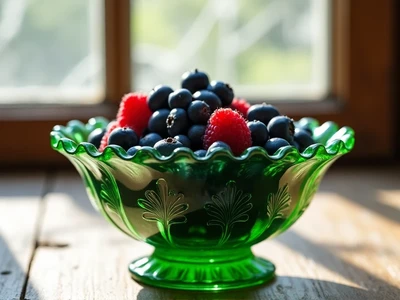Understanding Green Depression Glass: An Overview

The rich emerald and soft mint tones of green depression glass have captivated collectors for generations. These delicate treasures from America’s economic hardship have transformed from everyday household items into coveted collectibles that connect us to our past. At BrainTalking, we explore not only the historical significance of these beautiful pieces but also how collecting can become a mindful practice that supports mental wellness.
What is Depression Glass?
Depression glass refers to colorful, machine-made glassware produced primarily between 1929 and 1939 during the Great Depression era. Manufacturers created affordable, mass-produced glassware to provide functional yet beautiful items during economically challenging times. These companies used inexpensive manufacturing methods to create reasonably priced dishware accessible to struggling American families.

The name “”Depression glass”” directly relates to its production period during America’s most severe economic downturn. While it wasn’t called depression glass during that era, collectors later coined the term to identify this distinct style of glassware manufactured during those difficult times. Companies often gave away these glass pieces as promotional items with purchases of other products, or they were included in food packages as incentives to buy certain brands.
The Allure of Green Depression Glass
Among the many colors of depression glass, green depression glass holds a special place in collectors’ hearts. The verdant hues range from soft seafoam to deep forest green, with each shade carrying its own distinct appeal. Green depression glass became particularly popular because manufacturers found that adding uranium oxide to the glass mixture created these appealing green tones that captivated consumers.
Various shades of green depression glass emerged during this period, including light green (often called Jade or Jadeite), medium green (sometimes referred to as “”Depression Green””), and darker forest green varieties. One particularly fascinating type is Vaseline green, which contains uranium oxide that causes the glass to glow under ultraviolet light, giving it a distinctive yellowish-green appearance that collectors highly prize.
Identifying Authentic Green Depression Glass

For collectors interested in green depression glass, authentication requires attention to detail. Genuine pieces typically display certain characteristics, including small bubbles in the glass (a result of rapid manufacturing processes), mold seams, and occasional irregularities that indicate machine production rather than hand-crafting.
Popular patterns in green depression glass include “”Cameo”” (also known as “”Ballerina””), “”Princess,”” “”Cherry Blossom,”” and “”Georgian.”” Major manufacturers like Hocking Glass Company (later Anchor Hocking), Federal Glass Company, and Jeannette Glass Company produced these beloved patterns. Some pieces feature maker’s marks on the bottom, though many do not, making pattern recognition crucial for identification and authentication.
The Connection Between Diet and Mental Health
While green depression glass connects us to history, it also reminds us of simpler times when family meals and togetherness were central to well-being. This connection to communal dining offers a perfect segue into exploring how our food choices affect our mental health.
Introduction to Nutritional Psychiatry

Emerging research in the field of nutritional psychiatry suggests that what we eat significantly impacts our mental well-being. Dr. Drew Ramsey, a psychiatrist specializing in nutritional psychiatry, explores this connection in his book “”Eat to Beat Depression and Anxiety.”” Unlike traditional psychiatrists who focus solely on medication and therapy, nutritional psychiatrists examine how dietary choices influence mental health conditions.
Dr. Ramsey’s approach combines conventional psychiatric treatments with evidence-based nutritional interventions. His work emphasizes that food represents one of the most accessible tools anyone can use to improve their mental health. By understanding which foods support brain function and incorporating them into daily meals, individuals can actively participate in managing their mental wellness alongside traditional treatments.
Key Principles: Neuroplasticity, Epigenetics, and BDNF
Three fundamental concepts form the foundation of nutritional psychiatry’s approach to mental health: neuroplasticity, epigenetics, and brain-derived neurotrophic factor (BDNF).
Neuroplasticity refers to the brain’s remarkable ability to reorganize and form new neural connections throughout life. Contrary to earlier beliefs that brain development stopped in adulthood, we now understand that the brain remains malleable and capable of change throughout our lives. This flexibility allows the brain to adapt to new experiences, recover from injuries, and respond to nutritional interventions that support neural health.
Epigenetics explores how lifestyle factors influence which genes activate or remain dormant. Even if you have a genetic predisposition toward depression or anxiety, your lifestyle choices—including diet—can influence whether these conditions manifest and to what degree. This empowering concept means that hereditary factors aren’t necessarily destiny; our choices can significantly impact our mental health trajectory.
Brain-Derived Neurotrophic Factor (BDNF), often described as “”miracle-gro for the brain,”” promotes neural growth and protects existing brain cells from damage. Certain foods can boost BDNF production, enhancing cognitive function and potentially improving mood disorders. By consuming a diet rich in BDNF-promoting nutrients, we can actively support our brain’s health and resilience against mental health challenges.
Gut Health and Mental Well-being
The gut-brain connection forms another crucial aspect of nutritional psychiatry. Dr. Ramsey dedicates an entire chapter to gut health because emerging research shows that our digestive system profoundly influences our mental state.
Your gastrointestinal tract houses hundreds of millions of neurons that communicate directly with your nervous system. In fact, the gut contains the largest concentration of neurons outside the brain itself, forming what scientists sometimes call “”the second brain.”” This neural network facilitates constant communication between your digestive system and your brain, affecting everything from emotional processing to stress response.
The microbiome—comprising trillions of microorganisms living in your digestive tract—plays a vital role in this gut-brain relationship. A diverse microbiome supports optimal mental health, while imbalances may contribute to mood disorders. Consuming probiotic-rich foods introduces beneficial bacteria that enhance microbiome diversity and gut function.
Surprisingly, approximately 95% of serotonin (the “”happiness hormone””) production occurs in the gut rather than the brain. This reveals how intimately your digestive health connects to your emotional well-being. Dietary choices that support gut health may therefore directly influence mood regulation and emotional stability.
Incorporating Foods to Improve Mental Health
Just as collectors carefully curate their green depression glass collections, we can thoughtfully select foods that support our mental well-being. Dr. Ramsey identifies specific food categories that offer the greatest benefits for brain health.
Prioritizing Leafy Greens and Seafood
Leafy greens rank among the most powerful foods for mental health support. Dr. Ramsey recommends consuming 2-3 cups of leafy greens daily to maximize their benefits. Kale stands out as particularly beneficial due to its high concentration of vitamins, minerals, and antioxidants that support brain function.
Seafood provides essential omega-3 fatty acids that the brain requires for optimal functioning. Research suggests that omega-3s may help reduce inflammation in the brain and support mood regulation. Dr. Ramsey recommends including at least one small serving of seafood weekly in your diet to harness these benefits.
The combination of leafy greens and seafood provides complementary nutrients that support multiple aspects of brain health, from cellular repair to neurotransmitter production. By prioritizing these foods, you create a foundation for improved mental wellness through nutrition.
Rainbow Fruits and Vegetables: Eating the Rainbow
“”Eating the rainbow”” refers to consuming fruits and vegetables in various colors, each providing unique nutrients that benefit brain health. Dr. Ramsey recommends including 2-3 cups of colorful produce daily for optimal mental health support.
Red peppers and avocados stand out as particularly beneficial. Red peppers contain high levels of vitamin C, which supports stress response and immune function. Avocados provide healthy fats that the brain requires for structural integrity and optimal function.
The diversity of colors in your diet corresponds directly to the variety of nutrients you consume. Purple foods contain anthocyanins that support cognitive function, while orange and yellow produce provides carotenoids that reduce inflammation. Green vegetables offer folate and other B vitamins essential for neurotransmitter production. By literally “”coloring your plate,”” you provide your brain with a broad spectrum of protective compounds.
Focus on Seafood
While mentioned previously, seafood deserves special attention for its remarkable brain health benefits. Wild salmon, anchovies, and mussels offer particularly concentrated sources of omega-3 fatty acids and other nutrients that support brain function.
Dr. Ramsey recommends consuming 2-4 servings of seafood weekly to maximize these benefits. For those unaccustomed to eating seafood or who find the taste challenging, he suggests experimenting with various spices to enhance palatability. Garlic, lemon, herbs, and healthy spice blends can transform seafood dishes into appealing meals even for reluctant eaters.
Seafood provides not only omega-3s but also vitamin D, iodine, and selenium—nutrients that play essential roles in brain health but are difficult to obtain from other food sources. This makes seafood uniquely valuable for those seeking to improve their mental well-being through dietary interventions.
Collecting Green Depression Glass as a Mindful Practice
At BrainTalking, we recognize that hobbies like collecting green depression glass can themselves become therapeutic practices that support mental wellness. The process of researching, hunting for, and displaying these beautiful objects engages multiple aspects of mental health.
Collecting requires mindfulness—the practice of being fully present and engaged with your immediate experience. When examining a potential green depression glass purchase, collectors must focus intently on details like pattern, color, and condition. This focused attention pulls the mind away from rumination and worry, creating a meditative state that research shows reduces stress and anxiety.
The historical connection these objects provide also offers perspective on life’s challenges. Handling items that families treasured during America’s greatest economic hardship reminds us of human resilience. Green depression glass pieces survived decades to reach today’s collectors, tangible symbols of endurance through difficult times.
Key Takeaways for Mental Wellness and Green Depression Glass Collecting
- Green depression glass represents both historical significance and aesthetic beauty, with various shades ranging from light jade to deep forest green
- Nutritional psychiatry demonstrates how food choices directly impact brain health through mechanisms like neuroplasticity, epigenetics, and BDNF production
- Prioritize leafy greens (2-3 cups daily), colorful fruits and vegetables (2-3 cups daily), and seafood (2-4 servings weekly) for optimal brain health
- The gut-brain connection highlights how digestive health influences mental wellness, with serotonin production occurring primarily in the gut
- Collecting activities like seeking green depression glass can themselves become mindful practices that support mental well-being
Frequently Asked Questions
How can I tell if my green depression glass is authentic?
Authentic green depression glass typically shows small air bubbles in the glass, mold seams, and slight imperfections from machine production. Research the specific pattern of your piece to identify characteristic features. Genuine depression glass often has a slightly lower density than modern reproductions, though this can be difficult to assess without comparison pieces. When in doubt, consult with established collectors or appraisers who specialize in depression glass.

